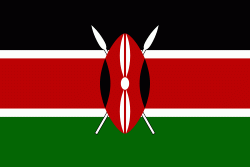Muranga District (Murang'A)
Murang'a County is one of the counties of Kenya's former Central Province. Its largest town and capital is Murang'a, formerly referred to as Fort Hall during the colonial era. It is inhabited mainly by and is considered the home of the Gikuyu, the largest ethnic group in Kenya. The county has a population of 1,056,640 based on the 2019 census.
When missionaries first came to Kenya, they found the Coast Region already inhabited by Portuguese, who had taken the coast, strategic for trade, from Arab powers in the 16th century. The missionaries ventured into Kenya's rugged interior and Murang'a was one of the first places they settled.
When the British set up the East African Protectorate in 1895, their first administrative post (Fort Smith) was located in Murang'a.
One of the main highlights of Murang'a's history, however, is the Mau Mau uprising that was led by the Agikuyu community who consider Murang'a their ancestral origin. Murang'a is thus considered, at least by some, the birthplace of the Kenyan independence movement.
Missionaries had initially been welcomed by Karuri Wagakure who was the chief of Tuthu. They set up the first mission church in Kenya at Murang'a.
Murang'a is also the source of Rivers Maragua, which originates from the heart of the Aberdare Range, Mathioya, Kayahwe, Irati and Muriurio among others.
Additionally, Murang'a is known for its fertile farming soil and good climate. Food crops such as maize, beans, sweet potatoes, arrow roots, pumpkins and bananas are grown in the region.
Tea and coffee are the county's main cash crops.
When missionaries first came to Kenya, they found the Coast Region already inhabited by Portuguese, who had taken the coast, strategic for trade, from Arab powers in the 16th century. The missionaries ventured into Kenya's rugged interior and Murang'a was one of the first places they settled.
When the British set up the East African Protectorate in 1895, their first administrative post (Fort Smith) was located in Murang'a.
One of the main highlights of Murang'a's history, however, is the Mau Mau uprising that was led by the Agikuyu community who consider Murang'a their ancestral origin. Murang'a is thus considered, at least by some, the birthplace of the Kenyan independence movement.
Missionaries had initially been welcomed by Karuri Wagakure who was the chief of Tuthu. They set up the first mission church in Kenya at Murang'a.
Murang'a is also the source of Rivers Maragua, which originates from the heart of the Aberdare Range, Mathioya, Kayahwe, Irati and Muriurio among others.
Additionally, Murang'a is known for its fertile farming soil and good climate. Food crops such as maize, beans, sweet potatoes, arrow roots, pumpkins and bananas are grown in the region.
Tea and coffee are the county's main cash crops.
Map - Muranga District (Murang'A)
Map
Country - Kenya
 |
 |
| Flag of Kenya | |
Kenya's earliest inhabitants were hunter-gatherers, like the present-day Hadza people. According to archaeological dating of associated artifacts and skeletal material, Cushitic speakers first settled in Kenya's lowlands between 3,200 and 1,300 BC, a phase known as the Lowland Savanna Pastoral Neolithic. Nilotic-speaking pastoralists (ancestral to Kenya's Nilotic speakers) began migrating from present-day South Sudan into Kenya around 500 BC. Bantu people settled at the coast and the interior between 250 BC and 500 AD. European contact began in 1500 AD with the Portuguese Empire, and effective colonisation of Kenya began in the 19th century during the European exploration of the interior. Modern-day Kenya emerged from a protectorate established by the British Empire in 1895 and the subsequent Kenya Colony, which began in 1920. Numerous disputes between the UK and the colony led to the Mau Mau revolution, which began in 1952, and the declaration of independence in 1963. After independence, Kenya remained a member of the Commonwealth of Nations. The current constitution was adopted in 2010 and replaced the 1963 independence constitution.
Currency / Language
| ISO | Currency | Symbol | Significant figures |
|---|---|---|---|
| KES | Kenyan shilling | Sh | 2 |
| ISO | Language |
|---|---|
| EN | English language |
| SW | Swahili language |















